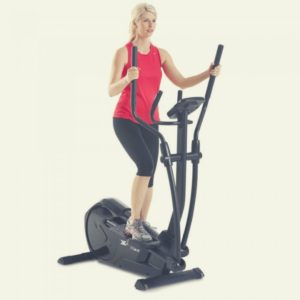For years, health buffs and workout enthusiasts alike have boasted about the benefits of running in place.
That being said, amid the controversy between whether or not it’s better than other types of cardio, including walking, running on a sidewalk or trail, or even swimming.
This article will explain why running in place is so beneficial to one’s health, as well as include some other tips on how you can use stationary running to improve your life in many aspects.
If you’re considering adding stationary running to your workout regiment, be sure to consult a doctor, physical therapist, or athletic trainer beforehand.
Running can be stressful on the body, whether in place or over long distances, and you’ll want to make sure your muscles and joints are healthy enough to take the strain.
Why Is Running In Place Beneficial To Your Health?
In general, running is an incredibly beneficial exercise that improves physical health in a variety of means.
Specifically, running requires and develops a strong core and upper body, as well as toned lower body muscles.
Running and jogging will help build strong bones, strengthen muscles, burn calories and help maintain a healthy weight.
For one, running in place is a viable option when you can’t go outside due to weather or conditional restraints.
But, even more so than that, if you put a bit of effort into your stationary running, you will burn some calories and increase your overall fitness.
Energy outputs from stationary running can be used to boost your heart health and help with weight loss.
This type of exercise will also raise your heart rate, generally up to 180 beats per minute, which can stimulate healthy lung function.
Overall, the average 150-pound person can burn 286 calories in a half-hour through an intense session of jogging in place.
As weight goes up, the calories burned in these sessions will go up as well. Therefore, if you weigh 130 pounds, you can expect to burn somewhere around 230 calories.
Cardiovascularly, stationary running can improve your health immensely. Specifically, when your body’s demand for oxygen raises your heart rate to a certain level, you’re improving your body’s cardiovascular system and burning unwanted fat at the same time.
It is also recommended that you exercise for at least 150 minutes a week, or 30 minutes a day five days a week.
That being said, stationary running can be used to achieve this goal easily, as it can be done from the comfort of your home, and even while you’re accomplishing other tasks.
Specifically, if you can jog in place for ten minutes at a time, three times a day, you will get the 30 minutes of exercise you need, burn a significant amount of calories, and feel better by living a healthier existence.
There are many other health benefits to running stationarily. In fact, research from 2015 indicates that running in place while engaging your abdominal muscles helps improve your posture!
Furthermore, stationary running requires individuals to constantly move and contract, improving not only muscle strength but also stability and flexibility.
Plus, this type of exercise is also beneficial to developing balance, coordination, and agility, which reduce the risk of injury due to falling.
Heart rate and improved blood sugar levels have also been linked to stationary running. And, if you have issues with your knee, jogging in place can help reduce knee pain while simultaneously making them stronger.
This is especially true if you’re running on carpet or padding, as it will reduce the impact and stress you’re putting on your body.
Because of this, if you’re planning on jogging in place in your home, and you don’t have any carpeted areas, it might be a good idea to purchase a yoga mat or something of the sort to run on.
A great way to run in place is to utilize a treadmill. This way, you’ll get a great cardiovascular workout and be able to easily track your progress with the treadmill’s system, including distance, speed, and calories burnt.
Plus, running on a treadmill can be more beneficial than simple stationary running in your living room because you have to propel your body weight forward, increasing both your heart rate and your calorie burn.
That being said, treadmills are expensive pieces of machinery. If you’re not looking to spend a significant chunk of change on a treadmill, jogging in place on the floor can be just as effective if done correctly.
Finally, incorporating stationary running into your exercise routines helps target muscles you might not be used otherwise, which can improve overall health and wellness.
How To Maximize Benefits From Running In Place
As mentioned above, there is an incredible amount of health benefits that can stem from jogging in place, one of the major ones being weight loss. This is especially true of stubborn belly fat. Other benefits include strengthening of muscles,
Similar to any other type of exercise, you’ll need to warm up before partaking in any sort of stationary running. Specifically, you’ll want to stretch your thighs, hamstrings, hip, and calf muscles.
You’ll also want to make sure you have the proper footwear for running. After securing your sneakers, stand with your feet shoulder-width apart, open up your chest, and face forward.
Next, you’ll want to pull your knees up and land on the balls of your feet. Increase your tempo and try to lift your knees as high as possible, as this will both increase the intensity and the calorie-burning aspect of the exercise.
In general, you’ll want to pull your thighs up so that they’re parallel to the ground.
At the same time, you’ll also want to move your arms back and forth to increase the cardio aspect of the exercise.
After exercising, you’ll also want to cool down with some easy running or walking in place to make sure your muscles have fully recovered from the workout.
If you’re just starting to run in place, you can start with an interval workout to give yourself some extra rest. You can start with 10-minute intervals, and build to 15 or 20 minutes.
For example, you can jog in place for 4 minutes, and then run faster for 2 minutes. After that, you can do a minute of bodyweight exercise, followed by three minutes of jogging in place, and then a few minutes of rest. This can be done as many times as you wish to get a good workout in.
As far as a schedule is concerned, it might be pertinent to include other exercises with your stationary running. Specifically, other cardio exercises that burn fat, and a healthy diet, will benefit weight loss.
Additionally,tracking your exercise progress using a fitness log or even a day planner can help you stick to your goals and continue improving your health.
Concerning diet, drinking at least 60 ounces of water per day, and eating foods that are rich in vitamins and protein, along with utilizing stationary running, will lead to significant overall health benefits.
Overall, stationary running can really improve overall health, as long as it’s done correctly and safely.
Precautions To Consider Before Stationary Running
In general, you’ll want to consult your doctor before beginning any new exercises, especially if you’re new to working out.
This is because any new type of exercise can lead to strain on your muscles, and can cause potential injury.
In running, whether in place or not, puts stress on many different bodily aspects, especially if you’re new to exercise. In particular, running puts a significant amount of stress on your hips, shins, and ankles.
If you feel like you’ve pushed yourself too far in running, stop and take a break. You’ll also want to build up your workout/running routine slowly, making sure you’re using the correct form.
While you’re recovering from soreness or injury, you will want to continue exercising with low-impact body movements.
If you want tips, on either how to recover more quickly or keep your body safe from injury, you can consult a physical therapist or personal trainer.
You’ll also want to make sure you’re stretching, both statically and dynamically, to decrease the amount of soreness you feel from the new type of exercise.
In particular,you’ll want to stretch your hip flexors, quads, glutes, and your back.
Stretching after working out can also lead to many benefits other than reducing soreness, including better flexibility and range of motion, better posture, and improve blood flow throughout the body.
Running In Place VS Running Outside VS Walking

Depending on your goals, any one of the above exercises can help you reach your fitness aspirations.
Stationary running and regular running utilize different muscle groups and different body mechanics.
When you run in place, you don’t have to propel yourself forward, meaning you won’t utilize the balls of your feet as much. Running forward will build ankle and lower leg strength.
That being said, landing on the balls of your feet will also put excess pressure on your knees and hips.
When running in place, you’ll have to lift your knees straight up, rather than forward, which requires less glute strength.
Muscle fatigue, soreness, or discomfort might occur more frequently during stationary running.
Regular running activates your hamstrings and glutes, maintaining their strength and also putting less strain on your hip flexors.
This all being said, jogging in place is great if you don’t have much time to exercise.
Utilizing stationary running for several ten-minute running sessions throughout the day can lead to great overall health improvements.
Walking can also be beneficial to your health and is generally easier on your joints than running.
Specifically, since walking puts less pressure on your joints, you can do it for longer periods of time, which can lead to an increase in calories burnt and weight loss.
Stationary running, while potentially more stressful on the body, may burn more calories, leading to increased weight loss.
It may also have a more positive effect on your body’s cardiovascular system than walking.
Overall, as long as you understand the health risks, and exercise safely any running and walking can lead to great overall health benefits.
How Running In Place Can Positively Affect Your Metabolism
There are a number of factors that can influence one’s metabolism, including genetics, diet, and exercise.
That being said, interval training is a type of exercise regiment that can boost an individual’s metabolism, and it can be used by incorporating stationary running.
Interval Training
Research has shown that interval training can burn more calories over a shorter period of time than other exercise regimens.
In fact, experienced exercise enthusiasts swear by the benefits of interval training.
Different lengths of work and recovery can bring forth varying benefits, all of which will improve overall fitness and health.
The above exercise regiment, under the maximizing your stationary running workout, is an example of interval training.
Oftentimes, treadmills also have interval training settings that will increase or decrease your speed and incline for you, maximizing your workout’s potential.
In any case, utilizing interval training can improve an individual’s metabolism, which can lead to increased weight loss.
Additionally, if you’re building muscle, which interval training can help with, you’ll also burn more calories.
Final Thoughts

As is stated above numerous times, jogging in place can seriously benefit anyone looking to kickstart an exercise routine without much time to go to a gym or take a run outside.
That being said, it’s important to weigh the benefits of jogging in place with the drawbacks.
Specifically, if you’re going to start a new workout regimen involving stationary running, it may be beneficial to check with a doctor, physical therapist, or even a personal trainer.
This way, you can be sure taking up stationary running won’t hurt your muscles or joints.
Overall, running in place can lead to serious health and fitness benefits, and should be utilized by more individuals in order to improve overall bodily health.



